Top 14 Interesting Facts About Mars
One of the most mysterious celestial planets in our solar system is Mars, which is located fourth from the Sun. Although we have known about the "Red Planet" ... read more...for thousands of years, it wasn't until the "Space Age" that we realized just how bizarre it is. So, if you have some curious about this planet, let's follow Toplist to discover some interesting facts about Mars.
-
Earth is larger than Mars. At its equator, Mars has a diameter that is roughly half that of the Earth. Additionally, Mars' circumference is almost half that of the Earth. 15% of the volume of the Earth is on Mars. In addition to being smaller, Mars is also less dense than Earth. Despite making up 15% of Earth's volume, Mars only makes up 11% of its mass. As a result, the gravitational attraction on the surface of Mars is only 38% as powerful as that on the surface of Earth. But, it's true, one of the interesting facts about Mars is Earth and Mars both have a similar amount of landmass.
Earth's volume is around 108.321 1010 km3, while Mars has a volume of 16.318 1010 km3, according to NASA. With an equatorial radius of 3,396.2 km and a mass of (very roughly) 0.64169 1024 kg, Mars is roughly half the size of Earth. Earth, on the other hand, has a mass of 5.9722 1024 kg, making it about ten times more massive.
So how could they have the same amount of land if Mars is so much smaller, one may wonder. Simply said, water covers the great majority of the Earth's surface. 71% of the surface of the Earth is covered by a massive ocean system. Although there is water on Mars as well, liquid water cannot last for very long due to the planet's low temperatures and tenuous atmosphere not on the planet's surface, at least.
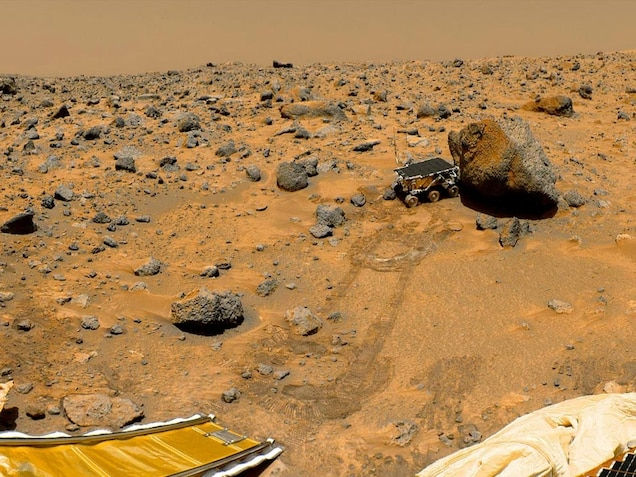
Photo; nationalgeographic 
Photo: mewallpaper -
Ancient Egyptian astronomers observed Mars despite how far away it was from Earth and noted it as a roving object in the sky. They were aware of the planet's retrograde motion by 1534 BC. As the number of sightings of the planet increased in detail, Galileo Galilei performed the first telescopic observation in 1610. Astronomers soon discovered unique characteristics of our neighboring planet, such as its polar ice caps, rotational period, and axial tilt.
Then, in the 19th century, larger telescopes enabled better views, and soon it was being detailed chart. They have dispatched numerous robotic spacecraft to explore the Earth from orbit and on the surface since the 1960s, with the amazing Curiosity Rover landing in 2012. Every month since then, these probes have assisted them in learning fascinating new knowledge, and it is exciting to think about what they will learn next.
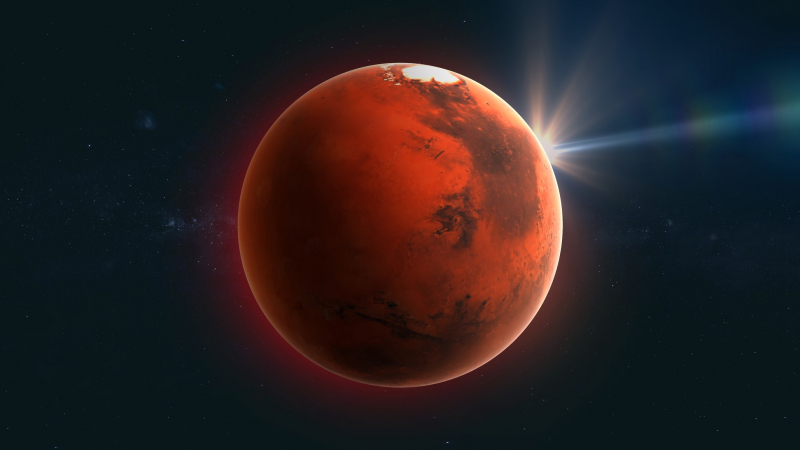
Photo: space 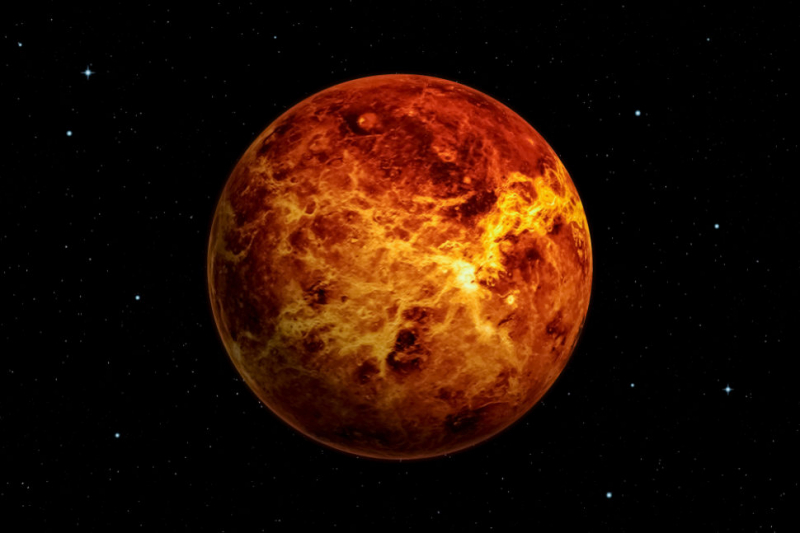
Photo: edgy.app -
The tallest mountain yet found on another planet is another interesting facts about Mars. This gigantic peak, known as Olympus Mons (Latin for "Mount Olympus"), is around 16 miles (25 km) tall and 373 miles (600 km) in diameter. That dwarfs any comparable peak on Earth due to its astounding size. Mount Everest, which stands 29,032 feet (8,849 meters) taller than us (above sea level), is a pitiful contrast.
However, as Mars lacks oceans as Earth does, it could be more accurate to compare it to another massive mountain, such as Hawaii's Mauna Kea, which rises 32,696 feet (9,966 meters, or 6.2 miles) above sea level (but just 13,728 feet of that is above sea level). But Mauna Kea is still dwarfed by Olympus Mons.
Olympus Mons is a shield volcano that is assumed to have been extinct for a very long time and that was active over a billion years ago. That occurred so long ago that it predates the most complex life forms on Earth, if not all of them. It is significant to note that some Mars specialists think the planet might still be somewhat active right now, given certain signs of more recent lava flows. This is hotly contested, though.
The tallest mountain in the solar system: Olympus Mons
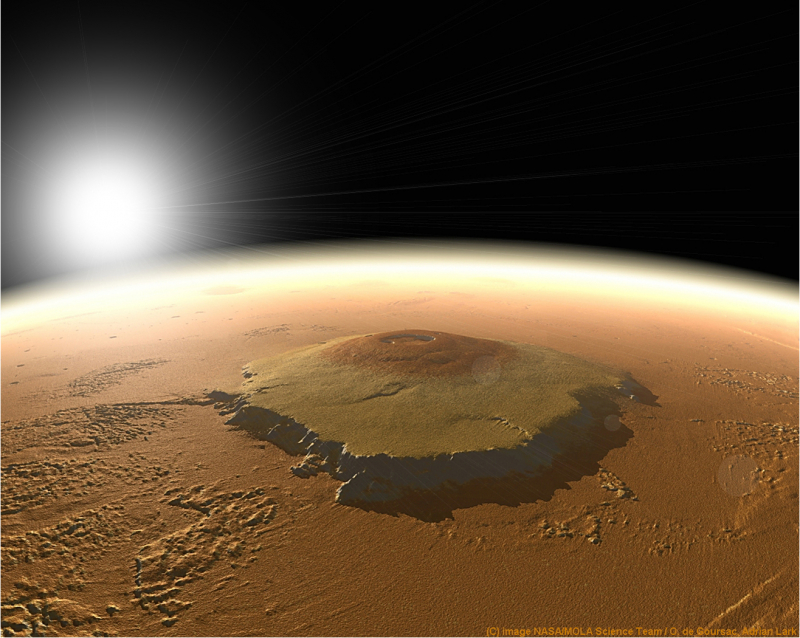
Photo: space 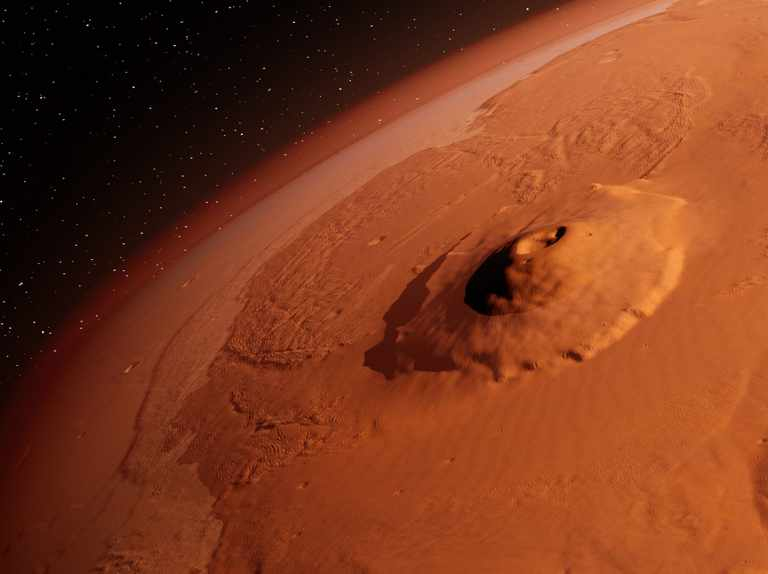
Photo: sciencefocus -
If you've ever wondered why our neighbor to the north is called Mars, it's because the Roman god of battle was known by this moniker. Reasonably, it is assumed that this has something to do with Mars' startlingly red color when viewed from Earth. In truth, the planet Ares was given that name by the ancient Greeks, who also used it to refer to their own battle deity.
What's more intriguing is that this custom did not just exist in ancient Europe. The hue of Mars has inspired other ancient cultures; Chinese astronomers named Mars "The Fire Star." The planet was known as "Her Desher" by the ancient Egyptians, who connected it to the god Horus (or "The Red One"). Her Desher Vallis is the current name of an old river valley on Mars.
The abundance of iron-rich dust and rock that cover the planet is what gives it its color. This is derived from the significant quantities of iron oxide minerals found on the surface of the planet, including hematite (Blood Stone), the typical iron ore on Earth. However, when the planet was still molten on Earth, most of the iron sank into the core, but Mars' smaller size and weaker gravity may have allowed more iron to remain close to the surface. It is still unclear to scientists how the iron oxidized (which turns it red and requires the presence of some form of oxygen).

Photo: mythopedia 
Photo: realonomics -
Phobos and Deimos, two minor moons of Mars, could be impacted by asteroids. They are shaped like potatoes because they don't have enough mass to float spherically due to gravity. The horses that pulled the chariot of Ares, the Greek god of war, gave the moons their names.
The bigger and innermost moon, Phobos, is extensively cratered and has deep ridges on its surface. It is slowly approaching Mars and will either collide with the planet or disintegrate within 50 million years.
Phobos and Deimos are roughly equal in size, although Deimos orbits Mars at a distance of 2.5 times greater. Strangely shaped, Deimos has a surface covered in loose material that frequently covers the craters, giving it a smoother appearance than pockmarked Phobos.
Two small moons of Mars: Phobos and Deimos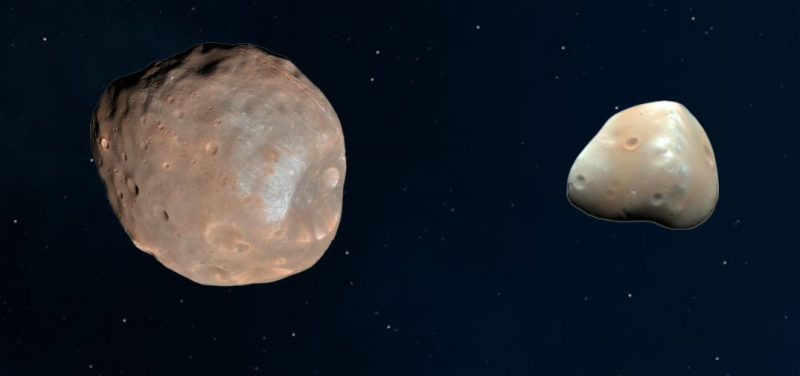
Photo: mars.nasa 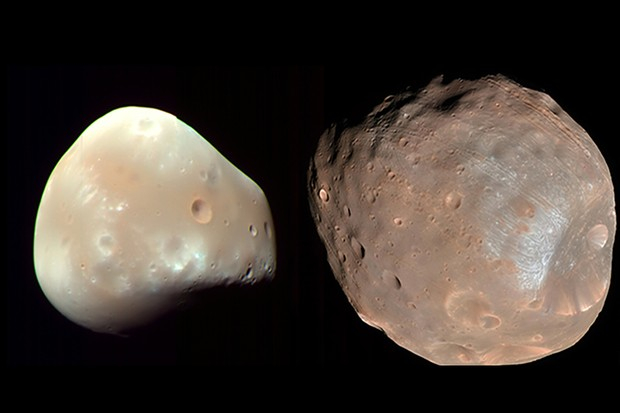
Photo: curiosmos -
Because of their distinctive circling rings, Saturn and Uranus are two of the Solar System's more unusual planets. But it turns out that Mars could receive its own ring in a few tens of millions of years, not to be outdone.
Astronomers predict that gravitational forces will eventually split apart Phobos, Mars' largest and most mysterious moon. As a result, a debris field will develop, which will eventually settle into a stable orbit and create a rocky ring around Mars. Phobos is the closest moon to its planet of any in the solar system, orbiting just 3,700 miles (6,000 kilometers) above Mars' surface. Phobos is being drawn in by Mars' gravity by around 6.6 feet (2 meters) per hundred years. In 30 to 50 million years, the moon will be torn apart, according to NASA.
But the ring won't last forever. It is predicted to persist for about 100 million years before breaking up and dropping to the surface of Mars. The early warning indications of this moon's impending demise are still visible today in a number of significant fissures on its surface.
The day that Mars should get it's our ring: in a few tens of millions of years
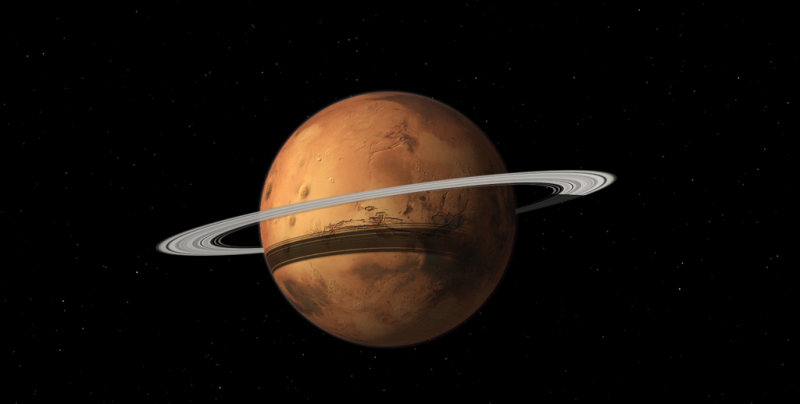
Photo: space 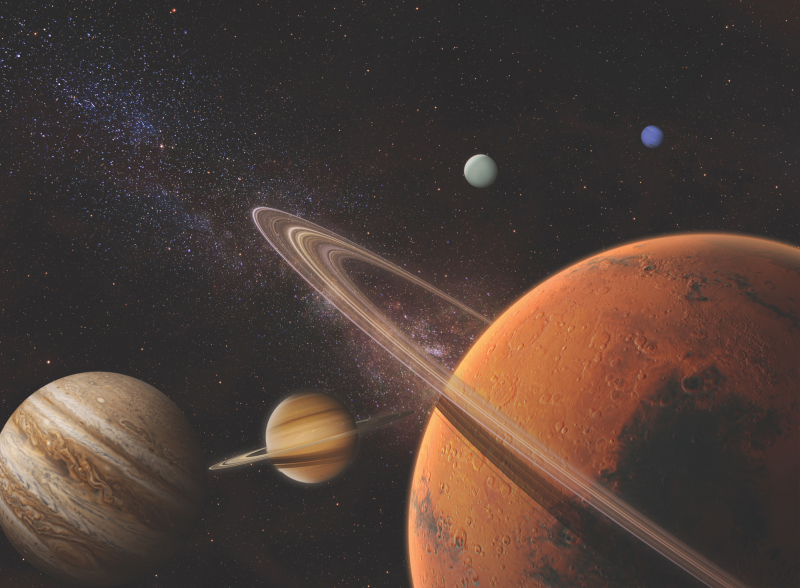
Photo: space -
In addition to having the tallest mountain in the Solar System, Mars is also home to a vast canyon known as Valles Marineris (or "Mariner Valley" in Latin). The canyon, or rather canyon system, is a breathtaking sight to see and stretches along the equator of the globe.
It has a length of about 2,610 miles (4,200 km) and is about 4.4 miles (7 km) deep in some spots. That would almost cover the entire continental United States from the Atlantic to the Pacific Ocean since it is that large. The Grand Canyon in Arizona is approximately 446 km (277 mi) long and 1.8 km (1.1 mi) deep, giving you an idea of its size.
The massive plate boundary known as the Valles Marineris actually moves so slowly over millions of years that little happens. Plate tectonics on Mars is quite primitive, and the division of the surface by the two plates moving past one another started about 3.5 billion years ago.
Enormous canyon of Mars: Valles Marineris
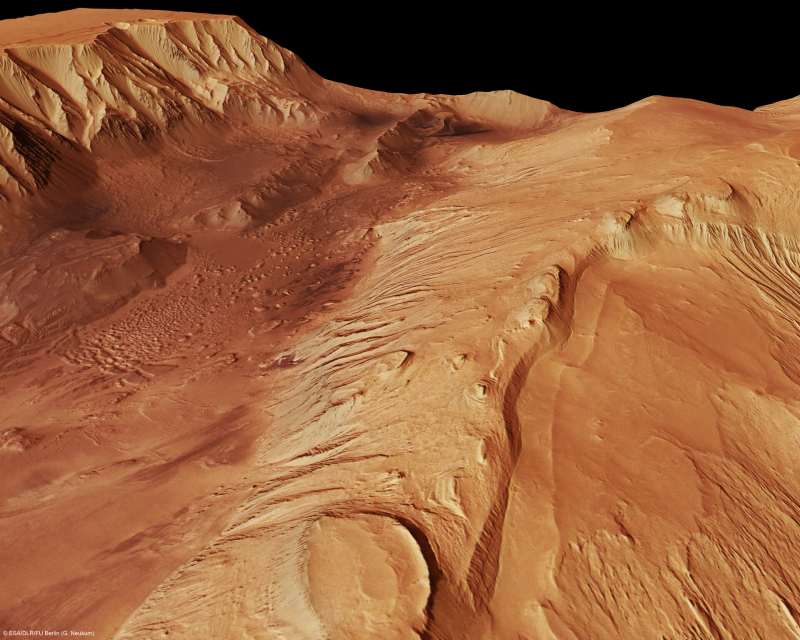
Photo: space 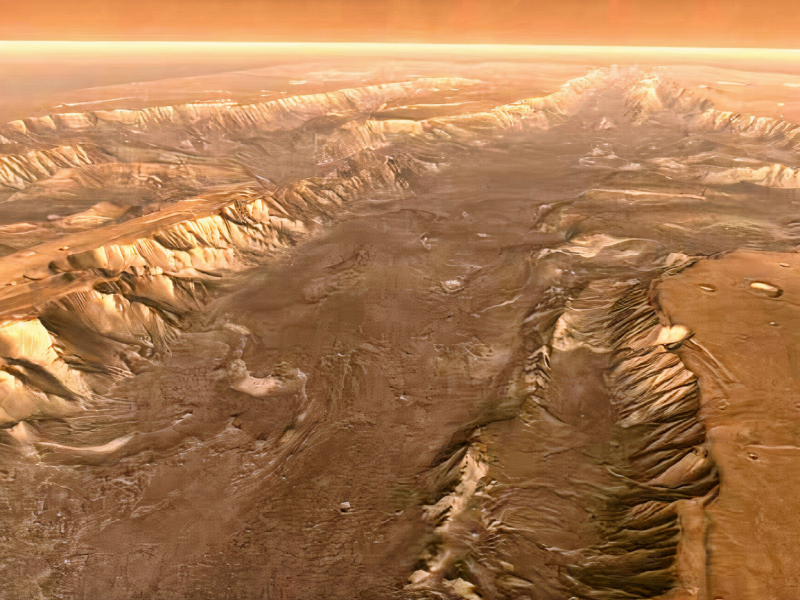
Photo: techeblog -
Mars has four different seasons, just like Earth. The Martian year is nearly twice as long as the Earth's, though, thus each season lasts roughly twice as long. Its Southern Hemisphere is slanted towards the Sun when Mars is closest to the Sun, while its Northern Hemisphere is inclined towards the Sun when Mars is farthest from the Sun. Because of this, the southern summer is substantially hotter than the northern summer. The greatest storms are sparked by the Southern Hemisphere's additional heat, which increases turbulence and strengthens winds.
The polar ice cap begins to shrink in the spring and may potentially completely vanish by the summer. The atmosphere becomes thicker as a result of the carbon dioxide emitted by the melting glaciers. The polar cap of that hemisphere begins to grow as autumn arrives as temperatures fall, occasionally reaching the middle latitudes in winter. Clouds can form in the northern summer, especially around the summits of volcanoes. At other times of the year, the tropics, the area on either side of the equator, can generate heat that can cause cloud bands to form in this region, much like they do on Earth. A few of these clouds may be seen by Beagle 2. However, there is never any rain on Mars due to dust clouds, however, ice coatings may occasionally appear on the planet's surface. Mars has freezing temperatures, even in the summer, with lows of -140°C. The occasional high of 20°C, nevertheless, might finally draw tourists.
Seasons of Mars: Spring, Summer, Autumn, Winter
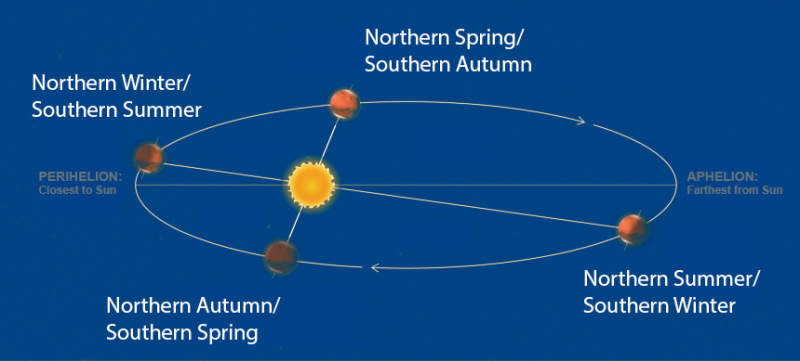
Photo: mars.nasa 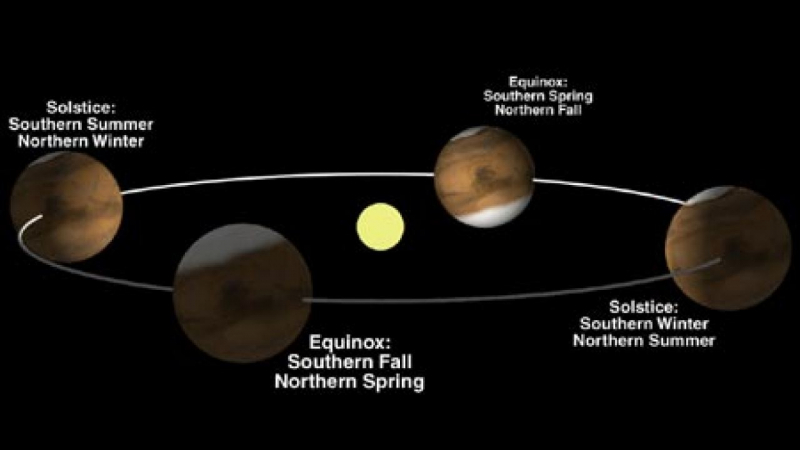
Photo: universetoday -
Another intriguing aspect of Mars is its amazing capacity to outperform the most advanced engineering that humanity has to offer. More than 50 missions have been sent to the Red Planet by different countries since 1960, but only approximately half of them have made it there safely.
The Soviet Union's 1M, also known as Marsnik 1 in the western media, was the first mission intended to reach Mars and it failed to launch in 1960. NASA's Mariner 4 completed the first successful flyby of Mars on July 14–15, 1965, and sent back images. About 55 probes have been launched or attempted to launch to Mars since then. Among these, many of the early Soviet Union attempts met with launch failures, and a number of additional attempts met with some sort of technical setback en route, in orbit, or on the planet's surface. This might have been partially caused by the nature of the operations and the rush to arrive with unprepared equipment.
The most recent initiatives have had better results. The Phoenix Lander in 2008, the MAVEN orbiter launched in 2013, the resourceful and tenacious Opportunity rover from 2014 to 2018, and the Curiosity rover all saw success for NASA (launched in 2011). More recent missions had also reached Mars, including the United States Perseverance rover and Ingenuity helicopter, the United Arab Emirates Hope orbiter (the nation's first interplanetary mission), and China's Tianwen-1 orbiter and lander-rover mission, which was the country's first successful mission to Mars.
Any "curse" that could have been afflicting the planet appears to have been more of a byproduct of the incredibly challenging journey there. However, the intention to launch a colony by 2050 may present some competition for Elon Musk and SpaceX
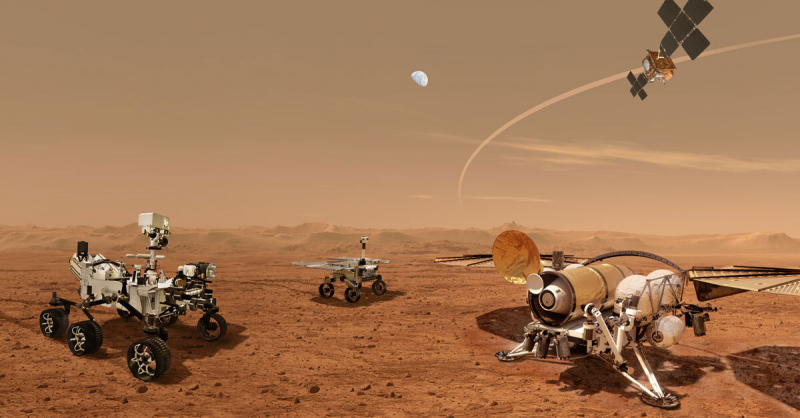
Photo: mars.nasa 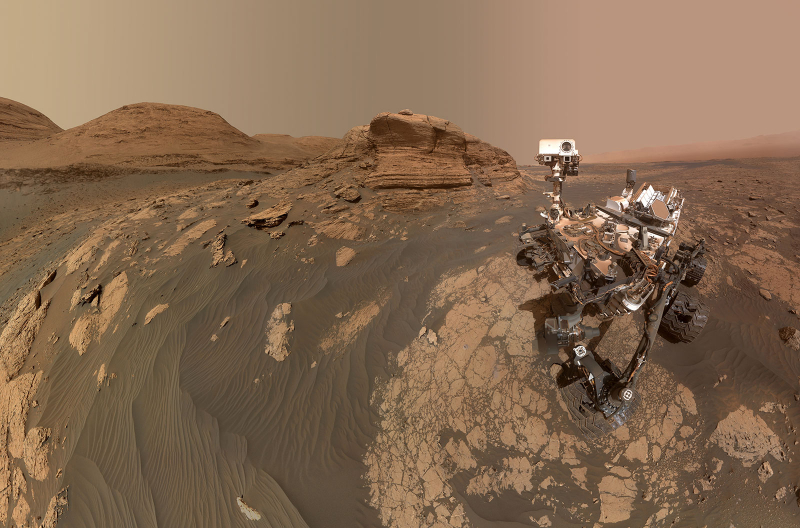
Photo: mars.nasa.gov -
Researchers think they have discovered evidence that tiny fragments of Mars have in fact touched down on Earth in the past is one of the interesting facts about Mars. These tiny rocks, which are known as "Martian Meteorites," have somehow managed to reach Earth.
It may seem inconceivable, but over time, pieces of planets' surfaces are blown off when objects like sizable asteroids collide with them. If the impact is large enough, these strikes unleash a ton of ejecta that can actually launch objects into space. This ejecta may possess sufficient energy to circumnavigate the Solar System and escape the planet's gravitational pull before coming into contact with another planet's center of gravity.
Furthermore, it appears that these kinds of incidents are rather frequent. By 2020, it is anticipated that about 277 meteorites discovered on Earth originated from Mars. Although it may seem like a lot, that represents less than 1% of all confirmed meteorites discovered on Earth. By analyzing rocks like this, scientists can learn more about the makeup of Mars' surface and perhaps even its former atmosphere.
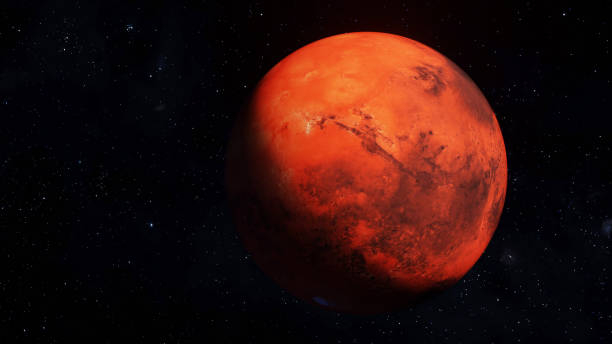
Photo: istock 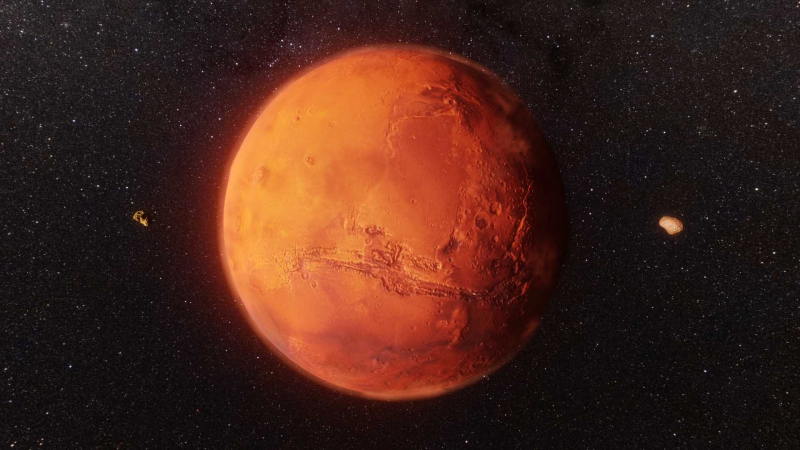
Photo: capitalfm -
If the planet's arid environment wasn't a sufficient deterrent, Mars' power also presents a risk.
These massive storms are brought on by Mars' eccentric orbit around the Sun. As a result, there may be temperature differences between the hemispheres, which might significantly increase atmospheric circulation and transport dust throughout the world. These powerful dust storms can last up to six months and blanket the entire planet.
One of the most recent ones was seen on camera in February 2022. It practically spanned the entire Southern Hemisphere of Mars and was twice the size of the United States. NASA's Insight lander also had to enter "safe mode" during the storm to conserve battery life because dust blocked sunlight from reaching the solar panels. Until the weather was better, NASA's Ingenuity Mars Helicopter was also forced to cancel flights.
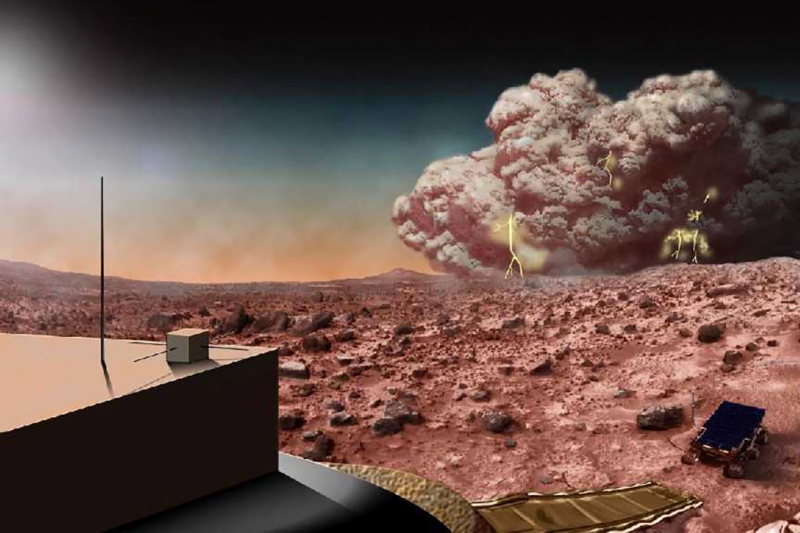
Photo: livescience Photo: National Geographic youtube channel -
The presence of water on a planet is regarded to be one of the primary requirements for life. Although liquid water is ideal for life as we know it, the mere fact that water exists at all suggests that life may exist on a planet (or has been present in the past).
In the case of Mars, scientists are certain that the planet's poles contain significant amounts of ice. Since the atmosphere of the planet is so thin, there is little to no chance that liquid water could exist there, as far as we know.
Outside of Mars' polar regions, whatever water that may exist is most likely also frozen. However, NASA spacecraft like the Curiosity Rover continue to scour the planet for probable sites where life might exist. Even if there isn't life on Mars, the vast amounts of frozen water will be a fantastic resource for any upcoming human settlements and missions to the planet.
But might this solid ice have ever been liquid? The scientific community is divided on this issue, and debates have been going on for more than a century. Several spacecraft have observed indicators of what appear to be ancient river channels, fluvial plains, and other hydrological features that may be proof of liquid water in the past, after early misinterpretations of formations that mimic deliberately created water canals.
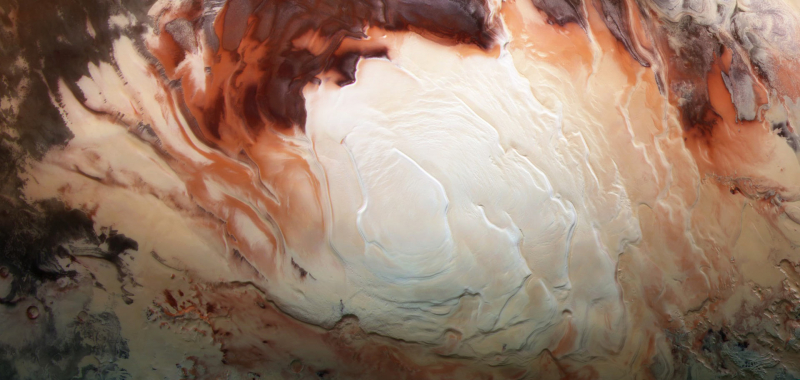
Photo: sci.news 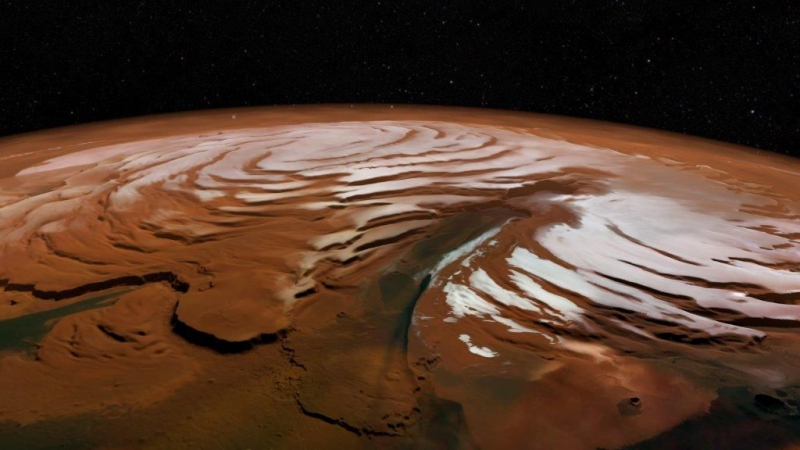
Photo: space -
The presence of gaseous methane in Mars' atmosphere is another fascinating fact. Methane has also been utilized, like water, as a potential sign of the existence of past or present life on a planet.
The Mariner 9 mission discovered methane in the atmosphere for the first time in 1971, and subsequent telescopic studies have subsequently documented radically varying methane levels over the years. Few spacecraft have been created to date with the ability to specifically probe for the element. However, the Curiosity Rover has noticed increases in methane in the region, and the cause is still mostly unknown.
Methane often forms on Earth as a consequence of microbial activity and human cultivation. However, geological processes like volcanism can also result in the production of methane. This is believed to be a more likely source for the gas given the abundance of volcanoes on the surface of Mars (particularly the huge Olympus Mons).
Even if it turns out that methane is not produced biologically, this is still excellent news for people because it will be a resource for future Mars colonists. In fact, companies like SpaceX intend to use it and Mar's plentiful water supply to aid in the production of commodities like fuel.
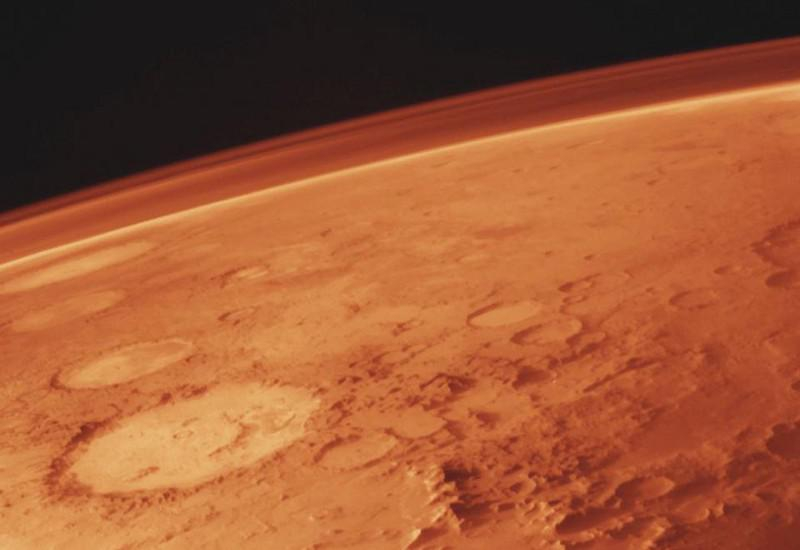
Photo: forbes 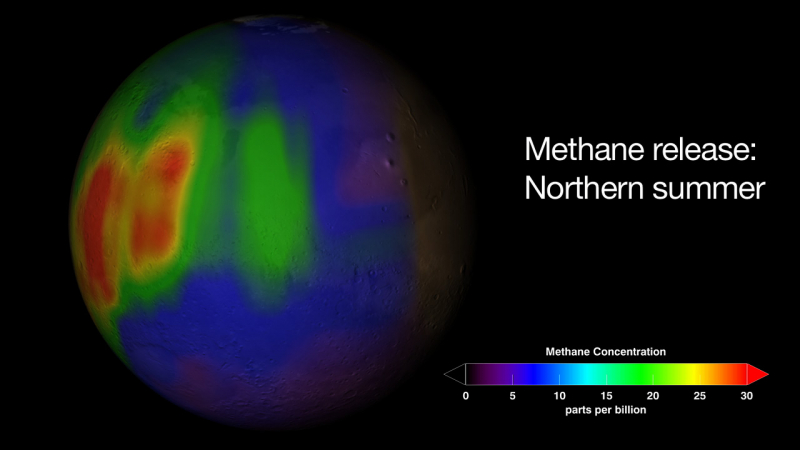
Photo: wikipedia -
On Earth, the sky is blue during the day and turns orange and yellow at sunset. On Mars, the exact reverse is happening. The "Red Planet" of Mars has a reddish-orange midday sky and a blue evening sky.
Only 1% of Earth's atmospheric pressure exists on Mars, where the "air" is composed of carbon dioxide and iron-rich dust, which scatters low-frequency red light and gives the sky its reddish hue. The Curiosity, Spirit, and Opportunity rovers have captured images of the blue sunset light that is visible when the red light is scattered away from the line of sight during sunsets on Mars.
According to Mark Lemmon of Texas A&M University, College Station, a member of the Curiosity rover mission's science team, "the colors arise from the fact that the very fine dust is the correct size so that blue light penetrates the atmosphere slightly more efficiently." "Blue light stays nearer to the Sun's direction than other colors of light do when it reflects off the dust. The rest of the sky is yellow to orange because red and yellow light scatters throughout the atmosphere rather than being absorbed or remaining near the Sun."
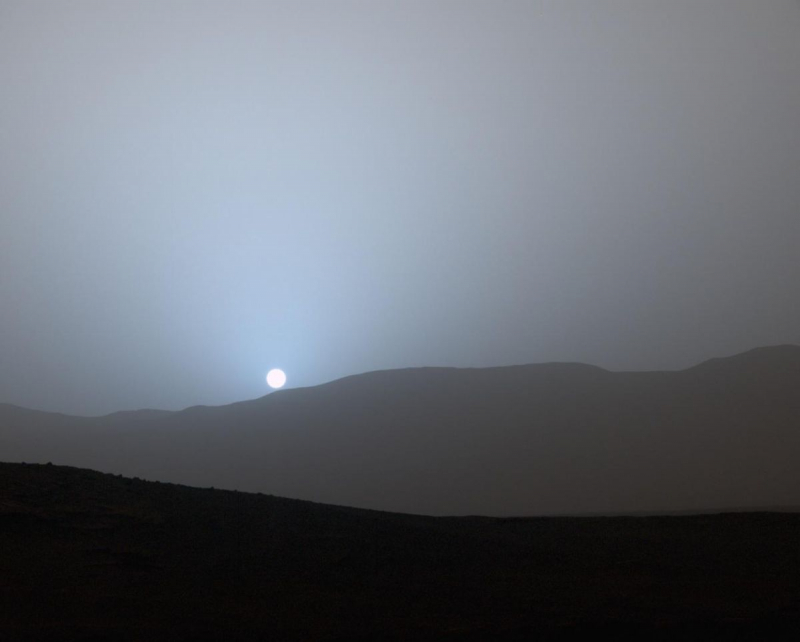
Photo: space 
Photo: iflscience



































